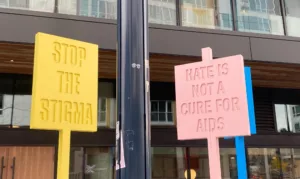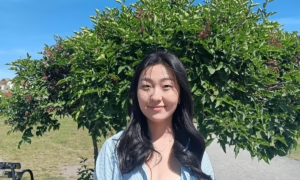The sun grants us many things: light, warmth, and copious amounts of vitamin D. Humans are, by nature, creatures of the sun. Our internal clock and societal agenda cater to the natural rise and fall of the star in and out of our skies. It dictates everything from the changing of seasons to the life of the house plant wilting in your living room.
Those living in Seattle know the importance of the sun. This is largely due to it being unreachable for longer stretches of time than we would like. The consistency of clouds and dreary forecasts cause us to savor any sunshine we can possibly feel on our skin. The reality of daylight saving time ending and the creeping in of colder, darker months have set in many of our minds. The time of darkness is once again upon us.
With the sun being so hard to catch along with other factors pertaining to the winter months, the inevitable arises yet again: seasonal depression.
Seasonal Affective Disorder (SAD) is a type of depression that affects individuals’ mental health in relation to the seasons. This typically aligns with people affected becoming more depressive during the winter months.
As the weather changes and the sun begins to disappear, people with SAD begin to take on symptoms associated with depression. This can manifest in numerous ways: losing interest in usual activities, low energy, weight gain/loss, sleep issues, hopelessness, and many other difficulties that affect one’s daily life.
While an exact cause for SAD has not been found, there are several reasons thought to lend a hand to the disorder. One of the biggest factors is sunlight. Sunlight helps to regulate important neurotransmitters like serotonin which is sometimes called the “happy hormone.”
With the loss of sunlight, those with SAD – who often have reduced serotonin activity in the first place – have less ability to transmit the hormone properly. Serotonin deficiency can result in symptoms associated with depression like insomnia, anxiety, and constant sadness.
The sun is also known for helping humans produce vitamin D. This vitamin is linked to boosting serotonin levels in the body. With less sunlight (and therefore less vitamin D) the benefits of serotonin are once again inhibited.
Melatonin is another hormone affected by sunlight. The less sun exposure a person gets during the day, the less regulated melatonin becomes in the body.
Melatonin is released by the pineal gland during the night and is commonly known for its role in sleep. The hormone is linked to the regulation of the body’s circadian rhythm. Melatonin imbalance can result in irregular sleeping patterns that can induce drowsiness, headaches, and trouble getting out of bed.
While the sun setting sooner certainly enhances SAD in individuals, DNA plays its role too. Like with other mood disorders, some individuals are just predisposed to SAD due to their genes and brain chemistry. Those who have SAD often have other mental health issues such as anxiety disorder or general depression. While these mental conditions typically affect an individual for the entire length of the year, having SAD alongside them can make the winter months even more difficult to deal with.
According to the American Psychiatric Association, 5% of U.S. adults are affected by SAD. It is not just a small patch of the “winter blues,” but something that can inhibit someone’s daily life for months. However, it is important to not self-diagnose. If you think that you may suffer from SAD – and if it is accessible to you – reach out to a doctor or mental health professional for a proper diagnosis and treatment plan.
While mental illness should be taken seriously, not everyone has access to a doctor or medication. Whether you find yourself in the midst of SAD or simply feel down due to the weather, there are a few things that could possibly help improve your mental and physical well-being.
Move your body
When you are feeling depressed, it can be difficult to make yourself do anything besides lay in bed. However, exercising is an amazing activity for easing symptoms of depression. Moving your body increases serotonin and dopamine production. It also helps the body release tension and stress. While working out may be the last thing you immediately want to do when affected by SAD, something as simple as a 10-minute walk can do wonders.
This tip is my personal go-to when I find myself in a depressive state. I always end up feeling astronomically better once I decide to get moving.
Socialize
With the ongoing COVID-19 pandemic, socializing can be difficult. However, if you find that you are able to safely spend time with loved ones, it may benefit your mental health. No matter how introverted an individual may be, humans are social creatures. We need human interaction in order to thrive.
Studies have shown that socializing can increase longevity, relieve stress, and decrease the likelihood of depression. Find time to connect with others whether that be through a phone call or a date at a coffee shop. Socializing and creating healthy relationships can leave you feeling uplifted and refreshed in order to combat the “winter blues.”
Light therapy
A new spin on combating SAD can be found in artificial light. Light therapy consists of using a box that emits a bright light that mimics sunlight. It allows users to gain the benefits of sunlight when they are not getting enough of it naturally.
That being said, it is best to use this device sparingly as it can increase headaches and eyestrain. However, if you feel in desperate need of extra sun, it may be beneficial to invest in a light therapy box.
Embrace the season
Sometimes, the best way to combat an issue is to let it run its natural course. Unfortunately, we cannot prevent the darker days that winter brings. Some of us also cannot prevent being affected by SAD. One way to ease ourselves into winter is to embrace it.
Seek out the things you love about the colder months, whether that be warm, homemade cookies or getting bundled up in your favorite blankets. Many individuals like to incorporate the idea of hygge into their lives in order to make winter more manageable.
While practicing a type of gratitude for the season may not solve all the problems that SAD can bring, it can help us feel more at ease with the world. I have always been a person to flow with the seasons, and I find it to be a comforting and helpful aspect when it comes to fighting depression.
Always remember that you are not alone in your struggles. Many individuals find themselves facing mental health issues. It is nothing to be ashamed of, and on the contrary, it could lead you to connect with others also dealing with conditions such as SAD.
If you find yourself struggling this winter, do not hesitate to reach out for help. Sometimes having a mental illness can feel like you are a burden to others, but you are not. Your emotions and feelings will always be valid, so please reach out if you find yourself in need. You are never alone.
National Suicide Prevention Hotline: (800) 273-8255

Mo is an alumni of Seattle Central and is currently attending the University of Washington with aspirations to pursue a career in journalism and communications while also delving into anthropology. She aims to explore the world and reveal the stories it wishes to tell through her writing and photography/videography. When she’s not captivated by her journalistic pursuits, she loves to go on adventures, create, watch films, and surf.












Be First to Comment